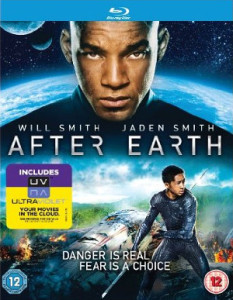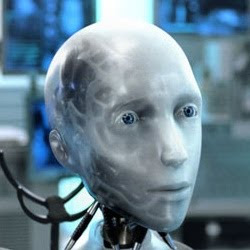 ** The review contains some mild spoilers, but not the major twists or ending **
** The review contains some mild spoilers, but not the major twists or ending **
Humanity damages Earth so much it isn’t habitable for humans, so they leave for a new world. This is attacked by aliens who track humans by their fear pheromones. But the aliens are beaten back after the emergence of Cypher (Will Smith) – a solider able to feel no fear, so he’s invisible to them.
As the film begins, Cypher is close to retirement, and has a strained relationship with his son Kitai (Jaden Smith). In an attempt to patch things up, he takes Kitai on his last mission, but the ship is damaged and crashes on Earth. With Cypher badly injured, it’s up to Kitai to travel through the wilderness and send a distress call. In the process, father and son have to face their differences.
General Thoughts
After Earth got very bad reviews, but the premise interested me enough to watch it anyway. I really enjoyed it. It’s not the action-adventure the marketing suggests, but a story about a father and son working through their issues (with some action backdrop).
There’s a lot of attention to detail in this. All the characters speak an invented futuristic accent, showing how language has continued to develop. The design of the colony avoids the excess and waste of the modern world, and their energy comes from turbines, as might be expected from a species trying to avoid making the same mistake twice. The changes in colour and texture of Kitai’s suit is also a nice touch.
Add in that this is a rare science fiction film where non-white/people of colour get the starring roles, and there’s a lot to like. This is not one of those futures where anyone brown mysteriously disappears, possibly because the aliens think they’re extra tasty.
Ecology
Earth is initially abandoned because humans made it uninhabitable (for humans). It’s placed under a harsh quarantine, which states that everything on Earth is out to get humans. I was worried when that was announced that it’d be like the King Kong remake, where animals attack humans in a single-minded way. But the quarantine is an exaggeration.
Given my interest in animal behaviour in films, I liked the different animal reactions. The spider Kitai first meets has no interest in him and doesn’t bite him. The first larger animal is checking to see if Kitai is a threat. Each animal has its own reactions, rather than being generic meatbags who want to kill all humans at any cost.
Reading Moby Dick, and the themes of hunting it contains, is used to overlay this. In the absence of humans, Earth is thriving, and species driven to near-extinction are abundant. The implication is the quarantine isn’t really to protect people. It’s to protect Earth.
As a criticism, I’d note that the timescale isn’t long enough for some of the adaptations shown to have evolved. Mimosa-like plant movement wouldn’t be a quick thing, for example. But it’s probably better not to overthink how the climate and ecology is really working.
Women
There are also scenes with Faia (Sophie Okonedo) the mother and Senshi (Zoë Kravitz) the daughter, but the primary focus isn’t on those relationships. In mild spoilers, because you find it out shortly after the opening, it’s clear something happened to Senshi. I felt the family reaction to this was good, rather than it being a throw-away tragedy to activate the plot. What I mean by this is the plot isn’t tragedy occurs so let’s kill aliens and never mention it again (looking at you, Starship Troopers film). It’s tragedy occurs and family has to deal with the emotional fallout.
That said, I wish we’d seen more of the Faia’s reaction to this. There’s hints she’s struggling to deal with it, but it’s not fully shown.
One common Hollywood trope is most side characters are men. There were women and girls in the crowds, but they didn’t get lines. This may seem a small thing, but it does detract from the realism.
If there’s a sequel, I hope they deal more with the family as a whole. And mix up the side characters a bit.
Disability
There’s a point when a solider who lost a leg in a previous battle thanks Cypher for saving him. This has good and bad sides. The good side is it shows the man is enjoying his life after becoming disabled. He’s genuine happy that he got to go home to his family. Life after disability shouldn’t be a rare protrayal, but it is. It’s often shown as a fate worse than death (and therefore death as a mercy).
However, the thing about wanting to stand to salute Cypher was rather over-hammed. He should have been able to stand with crutches, but he didn’t have any. I see how they wanted to link it in thematically to Cypher’s later injuries, but still… he could have had crutches.
Conclusions
I suspect some of the negative response was it not being as actiony as suggested. Someone expecting a kill-all-the-aliens war film will be disappointed. But I’m suspicious some criticism comes from the invented accent. People could think, “This accent is new to me. It’ll take some time until I’m fully able to get the tone of the speaker’s voice and notice small differences.” Or they could think, “This accent is weird. They must be terrible actors.” The latter is unfortunately the one people go for a lot of the time.
This isn’t hypothetical, given that people with composite accents in the real world tend to get those sorts of criticisms. Like the situation where Amal El-Mohtar’s accent was described as feigned and false.
However, if you like family tales with science fiction settings, an attention to detail, and Will Smith, you may well enjoy this film.

 Discussions of the movie I, Robot tend to focus on how Asimovy it really was (or wasn’t). I was interested in another feature: how the uncanny valley was used in movie. This post talks a bit about what the uncanny valley is, how I, Robot used it and how that might relate to non-visual fiction.
Discussions of the movie I, Robot tend to focus on how Asimovy it really was (or wasn’t). I was interested in another feature: how the uncanny valley was used in movie. This post talks a bit about what the uncanny valley is, how I, Robot used it and how that might relate to non-visual fiction.